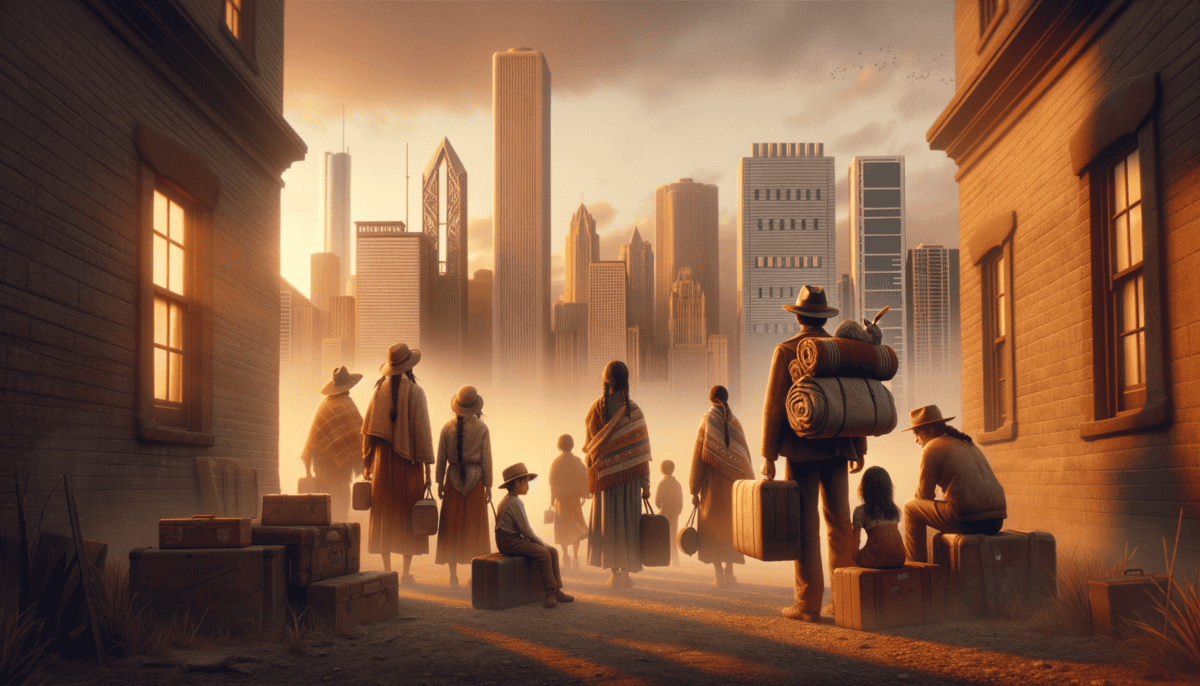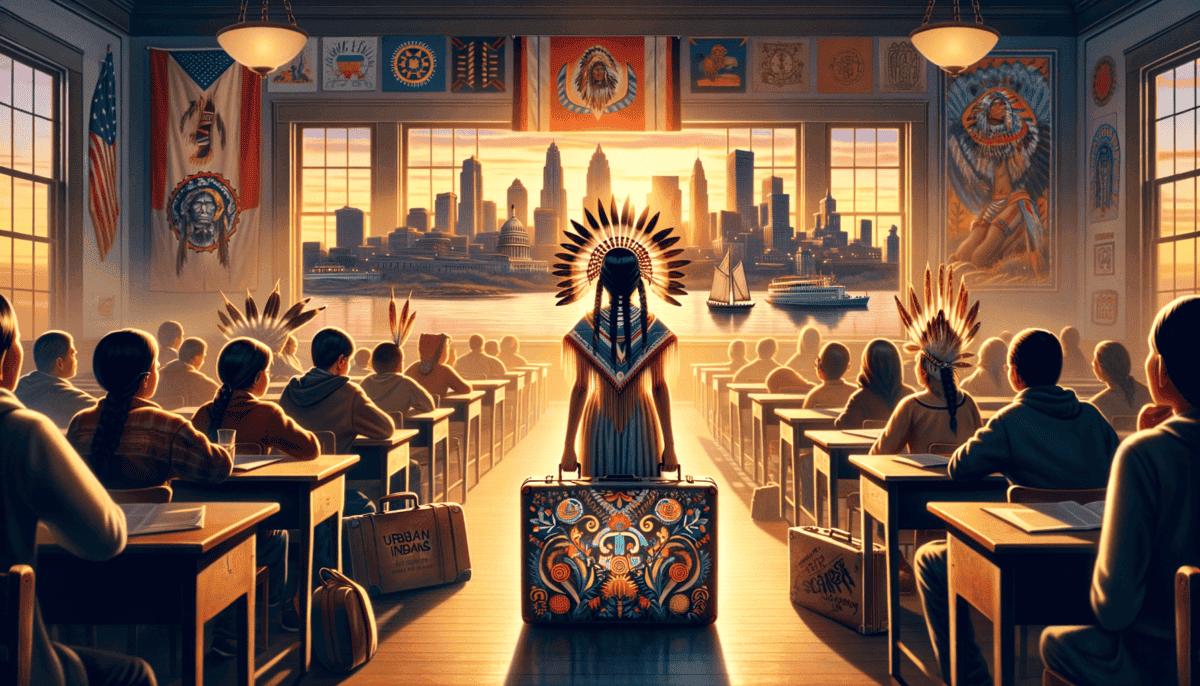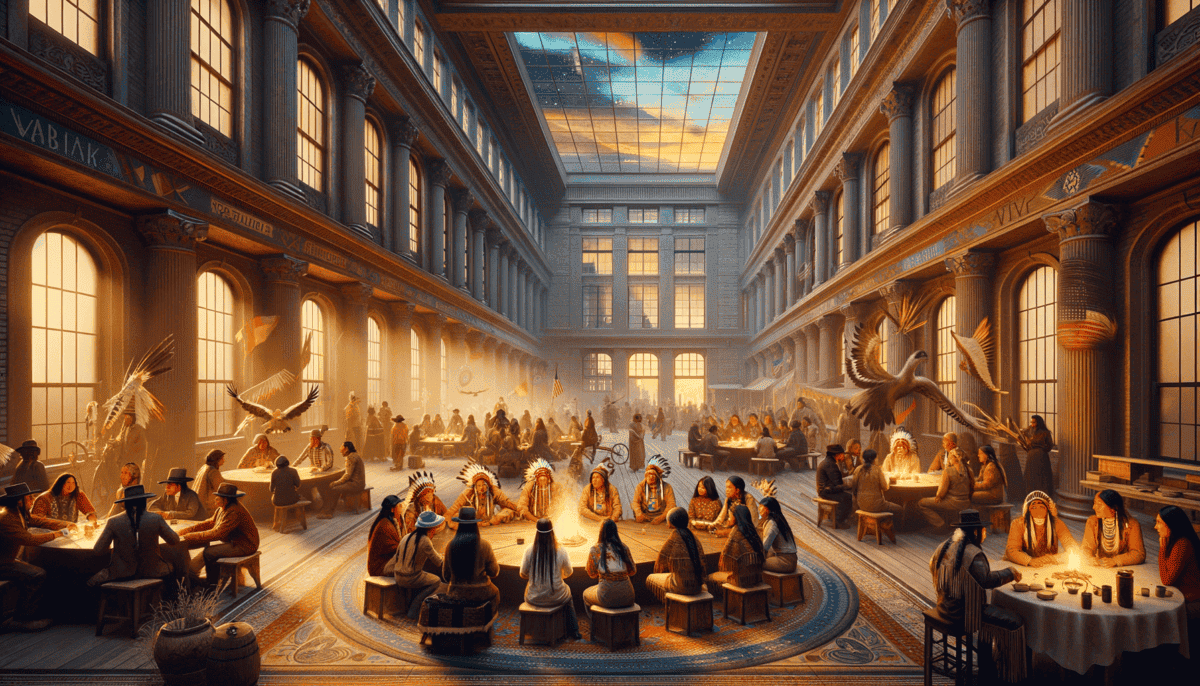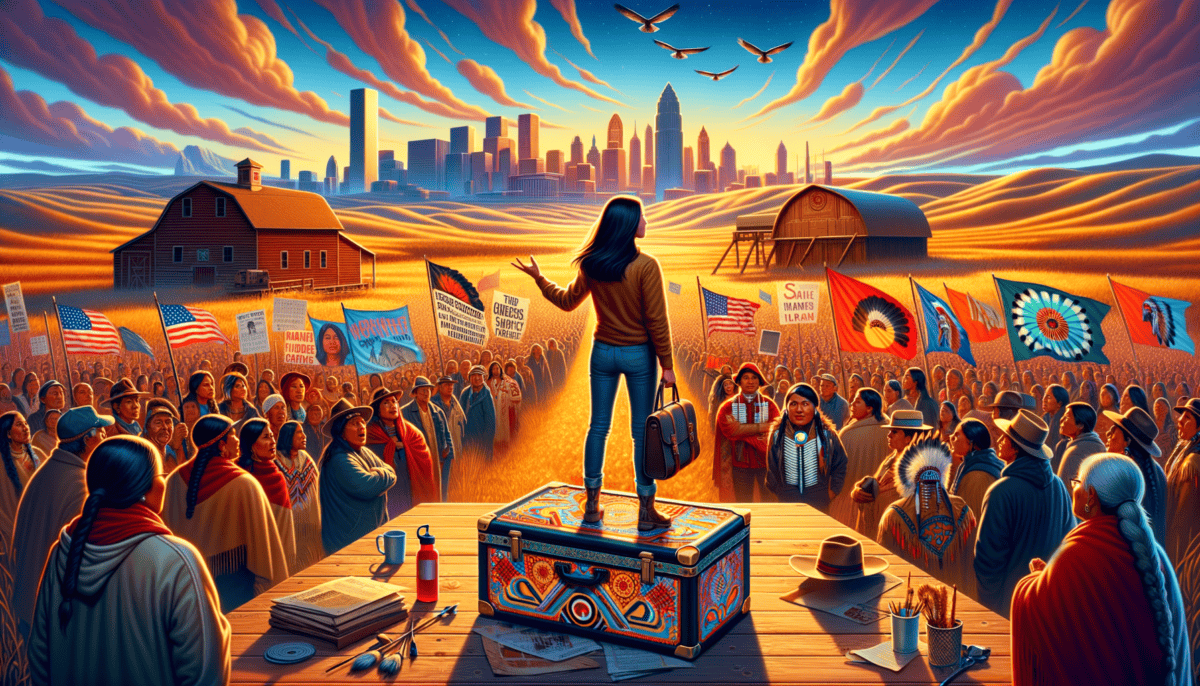Reservation Roots
Sarah Martinez stood at the edge of her family's sheep pen, watching the sun paint the Arizona desert in shades of orange and pink. The year was 1952, and at thirteen years old, she could feel big changes coming to her life on the Navajo reservation. 🌅
"Sarah! Time to help with dinner!" her mother called from their small wooden home.
The young girl took one last look at the vast landscape she had known all her life. The red rocks and dry earth stretched as far as she could see. This was home, but lately, everyone talked about leaving.
Life on the Reservation
"There's not enough work here anymore," Sarah's father said during dinner. He stirred his stew slowly, looking worried. "The trading post closed last month, and the wool prices keep dropping."
Sarah's mother nodded. "I heard Mrs. Begay's son moved to Chicago. He has a real job in a factory now!"
“The government man says they help Native families move to big cities,” Sarah’s older brother Tommy added. “They give you money for travel and help find jobs and houses.”
Sarah's stomach felt tight. She loved their small home, even if it didn't have running water like the houses in town. She loved helping her grandmother weave blankets and listening to the old stories.
The Big Decision
One sunny morning, a shiny black car drove up to their house. A man in a neat suit stepped out, carrying a briefcase. He was from the Bureau of Indian Affairs. 👔
"Good morning," he said with a big smile. "I'm here to tell you about exciting opportunities in Chicago!"
Sarah watched from behind the door as the man showed her parents colorful pictures:
• Tall buildings that touched the sky
• Clean factories with good jobs
• Modern houses with electricity
• Schools with new books
• Stores filled with food and clothes
That night, Sarah heard her parents talking late into the night. Her mother's voice was soft but worried. "What about our language? Our traditions?"
Her father sighed. "Maybe we can keep our ways alive somewhere new. We need to think about the children's future."
Making Plans
The next few weeks passed in a blur. Sarah's family started packing their belongings. Her grandmother taught her extra lessons about weaving and traditional medicines. 🧶
"Remember these things, little one," Grandmother said, pressing a small bundle of sacred herbs into Sarah's hand. "Our ways will keep you strong, even in the big city."
Sarah watched as her father sold most of their sheep. Her mother carefully wrapped their few precious items – the family blankets, ceremonial items, and old photographs.
Tommy seemed excited. "Just think, Sarah! We'll see buildings taller than mountains!"
But Sarah wasn't sure. The city in the pictures looked nothing like home. Would they still be Navajo there? Would they forget their stories and songs?
The government man returned with papers for her parents to sign. He talked about job training programs and housing assistance. It all sounded so different from their quiet life on the reservation.
That night, Sarah sat outside under the stars. The desert wind whispered through the sage brush, just as it always had. Tomorrow they would start packing the moving truck. Soon they would join the growing number of Native families heading to cities far from their ancestral lands.
She held her grandmother's herbs close and made a promise to herself. No matter where they went, she would hold onto who she was. She would learn new ways but keep the old ones too. Maybe that was what it meant to be Native American now – finding a way to walk in two worlds.
The stars twinkled above, ancient and unchanging. Sarah wondered if the same stars would shine in Chicago. She hoped they would help her remember where she came from, even as she headed toward somewhere new.
The Journey Begins
The moving truck rumbled down the dusty reservation road. Sarah pressed her face against the window, watching her home fade into the distance. Her grandmother’s herbs sat safely in her pocket. 🚛
Leaving Home
“Look! A train!” Tommy pointed excitedly as they pulled into the station in Flagstaff. Sarah had never seen a train up close before.
The station buzzed with activity. Other Native families stood with suitcases and boxes, all heading to different cities. Sarah noticed a girl about her age wearing a beautiful turquoise necklace.
“Hi, I’m Lucy. We’re going to Chicago too!” the girl said with a friendly smile. “My dad says there are lots of Indian families there now.”
The Long Ride
The train journey felt like it would never end. Sarah watched the landscape change through the window. The red rocks and desert turned into flat green fields. 🌄
Sarah and Lucy spent hours talking. Lucy’s family was Hopi, from a different reservation. They shared stories about home and wondered about city life.
“My cousin lives in Chicago,” Lucy said. “She says the buildings are so tall you can’t see the top!”
First City Sights
After three days on the train, Sarah woke up to a whole new world. Huge gray buildings filled the sky. Cars and buses zoomed everywhere. The air smelled different – like smoke and gasoline. 🏙️
“Look at all the people!” Tommy pressed against the window. Crowds rushed along the sidewalks below.
Sarah’s mother grabbed her hand tight as they stepped off the train. The station was bigger than their whole trading post back home. The noise was overwhelming.
A man in a suit met them with a sign that said “BIA Relocation.” He looked different from the man who visited them on the reservation, but he had the same big smile.
New Home
“Your apartment is in an area where other Indian families live,” the man explained as they drove through the city. “There’s a factory nearby where your father will work.”
Their new home was on the third floor of a brick building. Sarah had never lived so high up before. The apartment had running water and electric lights, but it felt small and dark compared to their reservation house.
That night, Sarah couldn’t sleep. Strange city sounds filtered through the walls – car horns, sirens, voices speaking languages she didn’t know. She held her grandmother’s herbs and whispered a prayer in Navajo.
Meeting Others
The next morning, Sarah met more Native kids in the building. Some were from tribes she had never heard of – Lakota, Ojibwe, Cherokee. They all had similar stories about coming to the city.
“We can teach each other our ways,” said Michael, a boy from Oklahoma. “My mom says we’re all related now.”
Sarah watched the kids playing hopscotch on the sidewalk. They spoke English instead of their tribal languages, but she noticed some wore traditional jewelry or had special braids in their hair.
At dinner, her father seemed tired but hopeful. “Tomorrow I start training at the factory,” he said. “And next week, you and Tommy will start at the new school.”
Sarah’s mother was learning to cook on an electric stove. “Different, but we can make it work,” she said, serving fry bread that tasted just like home.
That evening, Sarah found a small piece of sage growing in a crack in the sidewalk. She smiled, thinking maybe pieces of home could grow even here in the concrete city. She was scared about all the changes ahead, but knowing other Native kids were on the same journey made her feel braver.
The city lights glowed outside her window, not as bright as the desert stars but marking a new path forward. Sarah touched her grandmother’s herbs and whispered, “I can do this. I can be strong in this new place.”
Breaking New Ground
Sarah stared at the tall factory building where her father would work. The morning sun bounced off rows of windows, making them shine like mirrors. 🏭
Learning New Ways
“Today we learn about time cards,” said Mrs. Johnson, the job trainer. She wore a neat blue suit and spoke very slowly.
Sarah watched her father and other Native workers practice punching cards into a machine. Back home, they had followed the sun to know when to work. Here, everything ran by the clock.
“It’s different,” Sarah’s father said that night. “But the pay is good. We can buy food and pay rent.”
School Days
Sarah’s new school was bigger than her old one. The halls were full of kids who didn’t look like her. Some stared at her long black hair and turquoise jewelry.
“Where are you from?” asked a girl in her class. “Do you live in a teepee?”
“No,” Sarah said quietly. “My family is Navajo. We lived in a house.”
At lunch, Sarah sat with Lucy and other Native kids. They shared stories about home and helped each other feel less alone. 👥
Making Friends
After school, Sarah met more Native families at the Indian Center. It was a place where they could gather and talk about their problems.
“My mom can’t find work,” Lucy told Sarah. “They say she needs more training.”
The grown-ups talked about hard things – like finding jobs and dealing with people who didn’t understand their ways. But they also helped each other:
- Sharing job leads
- Trading childcare
- Teaching city skills
- Keeping traditions alive
Missing Home
Some nights, Sarah heard her mother crying softly. “I miss the mountains,” she would say. “I miss our family.”
But Sarah’s mother was strong. She learned to use the laundromat and shop at the big grocery store. She made friends with other Native moms in their building.
One day, Sarah came home to find her mother teaching the neighbors to weave. They sat in a circle on the floor, sharing stories as they worked. 🧶
Finding Balance
“We must be like the corn,” Sarah’s father said one evening. “Strong roots keep us standing, even in new soil.”
Sarah understood. They were learning city ways, but keeping their Navajo heart. Her grandmother’s herbs still sat on the windowsill, but now next to an electric lamp.
At the Indian Center, Sarah joined a dance group. Native kids from different tribes shared their traditional dances. Together, they created new steps that told their city stories.
Sarah wrote letters to her grandmother about everything they were learning. She drew pictures of the tall buildings and busy streets. Her grandmother sent back dried corn and sage, and stories from home.
The city was still strange, but Sarah’s family was finding their way. They were part of something new – a community of Native people helping each other grow strong in this concrete forest.
Building Our Circle
The Indian Center buzzed with excitement. Sarah helped her mother hang colorful blankets on the walls. The smell of fry bread filled the air. 🏢
A New Kind of Home
“More people come every week,” Lucy said, arranging chairs in a circle. Native families from all over the city were gathering today.
Sarah watched new faces enter – some wearing traditional clothes, others in city suits. They all shared the same hopeful look.
Many Tribes, One Family
“I’m Lakota,” said a boy with bright eyes. “I’m Cherokee,” shared a girl in braids. “Navajo here!” Sarah added proudly.
“We may come from different tribes,” Mr. Johnson, the center director, said. “But here, we are one big family. Together we are stronger.”
Keeping Traditions Alive
Every Saturday, elders taught traditional crafts. Sarah learned beadwork from a Cheyenne grandmother. She showed others how to weave like her mother taught her. 🎨
“See how the patterns tell stories?” Sarah explained to her new friends. Her hands moved quickly, weaving bright threads together.
Creating New Ways
The center started new programs to help everyone:
- Language classes to keep native words alive
- Job help desk
- After-school homework club
- Health clinic
Sharing Our Stories
At story circle time, children sat on colorful rugs. Elders shared tales from different tribes. Sarah loved learning about other Native nations.
“Each tribe is like a different color thread,” her mother said. “When woven together, we make something new and beautiful.”
Growing Stronger
The center helped in big ways too. When Lucy’s mom couldn’t pay rent, the community raised money. When someone found a good job, they told others. 🤝
“Remember how scared we were when we first came?” Sarah asked Lucy as they watched new families arrive.
“Now we help others feel at home,” Lucy smiled. “Just like others helped us.”
City Powwow
The biggest event was the city powwow. Drums echoed off tall buildings. Dancers in bright regalia spun through the park. People from all tribes celebrated together.
Sarah danced in her first powwow that day. Her feet moved to the drum beats while skyscrapers touched the sky above. Old ways and new ways danced together. 💃
A Place to Belong
“We are not alone anymore,” Sarah’s father said, watching the dancers. “Look how many of us there are now.”
Sarah looked around the center. Children played together while parents talked and laughed. On the walls, art from many tribes hung side by side.
This was their new village. Different from the reservation, but still full of Native pride and strength. Here, they were writing a new chapter of their people’s story – right in the heart of the big city.
Rising Voices
Sarah watched crowds gather outside City Hall. Native people from all over Chicago held signs and sang traditional songs. The year was 1961, and something big was happening. 🏛️
A New Kind of Power
“Why are we here, Dad?” Sarah asked, now fifteen and wearing her favorite beaded necklace.
“We’re here to make our voices heard,” her father replied. “The government needs to know we matter.”
Learning to Lead
At the Indian Center, Sarah joined the Youth Council. They learned about their rights and how to stand up for their community. 📚
“Your generation can make big changes,” Mrs. Running Bear told them. “You understand both worlds – the old ways and the new city life.”
Standing Together
Lucy and Sarah helped organize meetings. Native people shared stories about unfair treatment at work and school. They wrote letters to newspapers and city leaders.
“We’re not invisible anymore,” Lucy said proudly. “We’re showing everyone who we really are.”
Taking Action
The community worked together to make things better:
- Started Native American classes in schools
- Created job training programs
- Built health clinics for Native families
- Protected sacred objects in museums
Finding Their Voice
Sarah wrote for the Indian Center newsletter. She told stories about life in the city and memories from the reservation. Other young people shared their poems and art. 📝
“Our words are powerful,” her mother said. “They help people understand our journey.”
Growing Movement
News came from other cities. Native people everywhere were speaking up. They formed groups like the American Indian Movement to fight for their rights. ✊
“We’re not alone,” Sarah’s father said. “All across America, our people are standing tall.”
Making Changes
The community celebrated small victories. A Native teacher was hired at Sarah’s school. The hospital added a traditional healing room. More Native-owned businesses opened.
“Each step forward matters,” Mr. Johnson said at a center meeting. “We’re building a better future for our children.”
Pride and Progress
Sarah helped paint a huge mural on the Indian Center wall. It showed Native people in traditional dress standing next to city buildings. The past and present together, strong and proud. 🎨
“Look how far we’ve come,” Lucy said, adding bright colors to the painting.
“And we’re not done yet,” Sarah smiled, reaching for another paintbrush.
The Circle Grows
More people joined their cause. Some non-Native neighbors became allies, helping at protests and supporting Native businesses.
“When we work together,” Sarah told the Youth Council, “we can change anything. Our ancestors taught us to be brave. Now it’s our turn to be strong.”
A New Dawn
Twenty years had passed since Sarah first arrived in Chicago. The city looked different now, and so did she. 🌅
Seeds of Change
“Mom, tell me again about when you came here,” asked Sarah’s daughter Maya, now twelve.
Sarah smiled, touching the turquoise necklace she still wore. “It was 1952. I was just a scared girl from the reservation. Now look at us.”
Growing Roots
The Indian Center buzzed with activity. Kids learned traditional dances next to computer classes. Elders taught beadwork while young people studied for college. 🎓
“We didn’t lose our ways,” Sarah told her students at the cultural center. “We made them grow in new soil.”
Two Worlds Together
Maya played basketball and danced at powwows. She spoke English and knew Navajo prayers. She was proud of being both city-smart and tradition-wise.
“You’re like a bridge,” Sarah told her. “You connect our past to our future.”
Success Stories
The community celebrated their victories:
- Native doctors working in big hospitals
- Tribal members elected to city council
- Native-owned businesses thriving downtown
- Cultural centers in every major city
Healing Old Wounds
Lucy’s son became a lawyer, helping tribes protect their rights. Sarah’s brother opened a clinic mixing Western medicine with traditional healing. 🏥
“Our grandparents would be proud,” Lucy said during their weekly lunch. “We kept our spirit strong.”
New Generations
Young Native people filled college classrooms and office buildings. They carried medicine bags next to their laptops. They said prayers before board meetings.
“We can be anything,” Maya told her friends at school. “And still be Native.”
Looking Forward
The old reservation still called to Sarah sometimes. But Chicago was home now too. Her family had roots in both places, like a tree with branches reaching both ways. 🌳
“The city didn’t change who we are,” Sarah told the Indian Center gathering. “It showed us how strong we could be.”
Full Circle
Sarah watched Maya lead the Youth Council meeting. Young faces filled with dreams and determination. Just like she had been, so many years ago.
“Our story isn’t over,” Sarah thought, touching the center’s wall where the mural still shone bright. “It’s just beginning.” ✨
The Journey Continues
That evening, as city lights twinkled like stars, three generations gathered for dinner. Sarah’s parents, now elders, blessed the meal in Navajo. Maya set out fry bread next to deep-dish pizza.
“We are still here,” Sarah smiled. “Still growing, still dreaming, still Native. And that will never change.”






